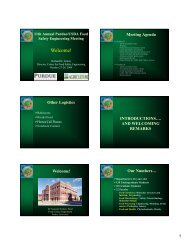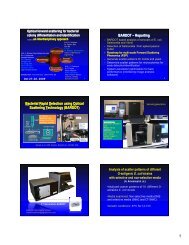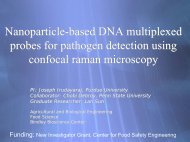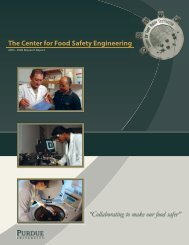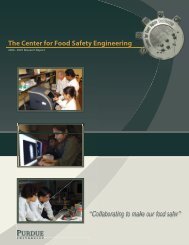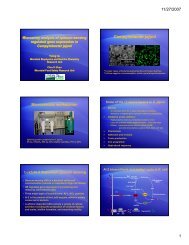Annual Report - Center for Food Safety Engineering - Purdue ...
Annual Report - Center for Food Safety Engineering - Purdue ...
Annual Report - Center for Food Safety Engineering - Purdue ...
Create successful ePaper yourself
Turn your PDF publications into a flip-book with our unique Google optimized e-Paper software.
IrudayarajNanoparticle-based DNA-multiplexed probes <strong>for</strong> pathogendetection using confocal raman microscopyInvestigator: Joseph Irudayaraj (Department of Agricultural and Biological <strong>Engineering</strong>)Project RationaleThe overall goal of this research is to develop a probefabrication and assay synthesis protocol <strong>for</strong> multiplex DNAdetection of food pathogens by surface-enhanced ramanscattering (SERS) utilizing non-fl uorescent, label-containingnanoparticles as DNA probes. Although research on SERSlabeledDNA examination is very active, it is still in its earlystages with regard to multiplexing and detecting analytes atlow levels. We are capitalizing on the unique spectroscopicsignatures (down to ~1 nm resolution) of non-fl uorescingmolecules as labels (raman tags) to identify specific DNAsequences. Because of the distinct fi ngerprint of the labelsdue to SERS, simultaneous detection of multiple DNAhybridizations without separation is feasible at sub femto molar(fM) sensitivity.Several aspects are unique to this research. We can usemultiplex labeling in one system using a range of nonfluorescing labels. A one-pot plat<strong>for</strong>m <strong>for</strong> detection of foodpathogens at sensitivities not af<strong>for</strong>ded by fl uorescence methodsis possible using our approach. Incorporation of a magneticseparation step will enable the separation of target sequencesin complex media. Using non-fl uorescent labels [~$10-20/gm] <strong>for</strong> multiplexing is many orders cheaper than fl uorescentlabels [~$10-20/mg]. Furthermore, the choice of SERS labelsis enormous (over 1,000 labels) and extremely sensitive, andsingle-molecule identifi cation has been reported. This impliesthat eventually the detection can be accomplished without theamplifi cation step.This novel technology, once fully developed, has the potentialto detect multiple analytes in a benchtop setting. Further, SERSprobes have the potential to be incorporated into living cells toenable real-time monitoring of structural features and electrontransfer processes that occur along the DNA helix. This wouldpotentially support probing of DNA damage and splicingmechanisms.Project Objectives• Investigate the effectiveness and effi ciencyof fi ve cheaper non-fl uorescent dyes asraman labels to be used as SERS tags.• Synthesize SERS-DNA probes <strong>for</strong> detecting speciesspecific DNA sequences of E. coli O157:H7,Campylobacter sp., Staphylococcus aureus, Listeriamonocytogenes, and Salmonella sp. as targets.• Develop a one-pot multiplex detection system usingthe optimized SERS-DNA probe to simultaneouslydetect E. coli O157:H7, Campylobacter sp., andSalmonella sp. in milk and water samples.Project HighlightsWe demonstrated that up to eight non-fl uorescent raman tagscan be chosen with distinct signatures <strong>for</strong> visual multiplexingutilizing the SERS spectra. The fabrication step has also beenoptimized and detection sensitivity of up to 1 fM is achievable<strong>for</strong> the chosen labels. We demonstrated multiplexing of up toeight probes <strong>for</strong> a chosen DNA sequence. We also showed thathybridization of eight different DNA sequences (depicting eightprobes) at one time can be detected. Finally, we developed astrategy to detect DNA sequences in an array (on a glass slide)as well as in a test tube (a one-pot analysis) <strong>for</strong>mat.In summary, our key accomplishment was the demonstrationof an eight-plex nonfl uorescent DNA detection assay usingraman spectroscopy. Steps to standardize the assay <strong>for</strong> directdetection of target sequences without the PCR simplifi cationstep is underway. This technique could be utilized as a slide(lab-on-slide) or tube (lab-on-tube) <strong>for</strong>mat <strong>for</strong> pathogen anddisease detection.8<strong>Center</strong> <strong>for</strong> <strong>Food</strong> <strong>Safety</strong> <strong>Engineering</strong>“...our key accomplishment was the demonstration of an eight-plexnonfl uorescent DNA detection assay using raman spectroscopy.”



